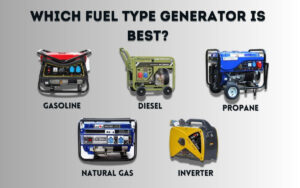Standby vs. portable generators
Sudden power outages have made us more aware of our dependence on electricity. If you want to power your home during a power outage, a generator is your best option. Among the various options available, standby generators and portable generators have emerged as two of the most popular solutions.
The purpose of this article is to provide a comprehensive comparison of standby generators and portable generators. MATCHUP aims to provide detailed insights into their features, pros and cons, and practical considerations for choosing them. After reading this article, you will be better able to decide which type of generator is best for your specific needs.

What is a standby generator?
Often referred to as a whole-house generator or stationary generator, a standby generator is a permanent power solution designed to provide uninterrupted power during a power outage. Standby generators are permanently installed outside your home or business and are connected directly to your electrical system via an automatic transfer switch (ATS). They automatically start within seconds of a power outage, ensuring continuous power without any human intervention. When the main power is restored, the ATS switches back to utility power and the generator shuts down.
Standby generators range in power from 8 kW to 100 kW. Standby generators are typically capable of powering a wide range of appliances and systems, including HVAC equipment, refrigerators, medical equipment, and more. Standby generators use diesel, propane, or public natural gas. Power is provided for longer periods of time, often days or even weeks, depending on the situation and fuel availability.
Standby generators have an insulated cover that is usually weatherproof. Therefore, unlike portable generators, they can be used outdoors continuously, rain or shine.
However, the initial investment for a standby generator is much higher. This includes the cost of the unit itself as well as the installation fees. This includes setting up the equipment, connecting it to the electrical system, installing automatic transfer switches, and integrating it with the fuel supply, among other things.
What is a portable generator?
As the name implies, portable generators are easy to move or carry from one place to another and are designed to provide power while on the go or during a temporary power outage. Traditional open-frame generators and compact, ultra-quiet inverters are the best-known types.
How do portable generators work? Portable generators are started and stopped in a simple, manual manner. To use a portable generator, you must ensure that it is placed in a well-ventilated area away from your living space. Then, depending on the model, start the generator using a pull-start or electric start button. Once running, plug your appliances and devices directly into the generator’s outlet or use an appropriate extension cord. They can produce 1,000 to 15,000 watts of power and can only power a limited number of appliances at once.
Many portable generators use different types of fuel, including diesel, gasoline, propane, or natural gas, and typically have small to medium-sized tanks ranging from 0.9 to 20 gallons. Some newer dual-fuel generators can run on both propane and gasoline.
So, are all portable generators “portable”? Only some portable generators can be taken with you. Some are quite large, weighing over 150 pounds. However, they have features like oversized wheels and handles that make them portable. These generators can be easily stored in a garage, shed, or other storage space when not in use, freeing up outdoor space.
In summary, portable generators are a cost-effective and flexible solution for temporary power needs, often with a lower upfront cost than standby generators.
Comparing standby generators and portable generators
When deciding whether you need a standby standby generator or a portable generator, you must first understand the differences between these generators.
Power requirements
One of the main considerations when choosing between a standby generator and a portable generator is power requirements. You should list your most important appliances and determine how much energy each uses. Appliances such as refrigerators, sump pumps, and HVAC systems have different power requirements, and some require more power to start up than to run continuously.
Standby generators typically range from 8,000 to 100,000 watts (and more for larger commercial applications). Portable generators have a maximum output of about 15,000 watts.
Fuel type and efficiency
Generators use a variety of fuels, each with its own unique advantages and disadvantages. Consider both fuel efficiency and run time when evaluating your options.
Standby generators use natural gas, propane, or diesel as their fuel source. They connect directly to the fuel source, ensuring uninterrupted power during extended power outages. Natural gas and propane are available continuously and are cleaner burning. Diesel fuel has a high energy density and can run longer.
Portable generators typically use gasoline. Gasoline is considered the most common fuel for portable generators. There are other models of portable generators that use diesel and propane. At half of its rated load capacity, a 6,500-watt portable generator uses about 18 gallons of fuel per day. You must refuel manually, which can be a hassle and pose a safety risk if not done correctly.
Budget and long-term costs
Both the initial investment and ongoing costs should be factored into your decision. The initial cost of a standby generator is higher because of the cost of the generator set and professional installation. Ongoing costs include routine maintenance performed by professionals to ensure reliable performance. The upfront cost of a portable generator is much lower than a standby generator. And maintenance can usually be done by the owner, including changing the oil and filter and ensuring proper storage.
Portable generators are designed for short-term surges – usually about 6-18 hours and can last a total of 1,000 hours. Standby generators, on the other hand, are designed specifically for longer emergencies. They can last up to 3,000 hours. The longer the running time of a standby generator, the more cost-effective it will be.
Noise level
Noise pollution is an important factor, especially in residential areas. Standby generators are usually quieter due to better insulation and noise reduction.
Safety
When in use, all generators release a large amount of carbon monoxide gas. Therefore, never operate a generator indoors, such as in a garage, and always operate it outdoors, away from doors and windows.
Compared to traditional portable generators, standby generators enhance safety through features such as automatic shutoff, built-in diagnostics, and carbon monoxide detectors. In addition, standby generators are usually installed outdoors, eliminating this risk.
Installation and mobility
The ease of installation and requirements of the two types of generators are significantly different.
Portable generators rarely need to be installed. They are suitable for use outdoors, in RVs, and houses. For example, by pushing a portable generator into a field, you can provide power for mowing the lawn. When camping in a secluded area, you can power a barbecue or charge a laptop or smartphone. Even large and heavy generators can be moved on wheels.
On the other hand, standby generators require a certified technician to set up, including complex electrical work and connecting to a fuel source. Once installed, they remain in a fixed location, usually on a concrete pad outside a home or business. This may also require a permit and sometimes additional approval from the fire department for professional installation.
Conclusion
Choosing between a standby generator and a portable generator depends largely on your specific needs. Both types of generators have their own unique benefits and ideal applications.
If you need to ensure continuous power to a large residence, business, or essential systems that cannot be interrupted, a standby generator is your best choice. Its high capacity, automatic start, and permanent installation provide reliable, seamless backup power.
Portable generators are ideal for those who need backup power for basic household appliances, or need power for activities such as camping or RVing. Portable generators are cost-effective and flexible, making them ideal for temporary use and small applications.
Whatever your power needs, having the right generator can provide peace of mind and safety during unexpected power outages or recreational use. MATCHUP’s extensive generator line includes both standby and portable models, ensuring you can find the best generator for your situation.


May Ge
Outdoor Machinery Export Manager 6-Yr Exp 🌍 ∣ BSCI, EPA, EURO V, CE ∣ Generator, High-pressure Washer, Water Pump, Engine, Floor Scrubber ∣ 🚀 24/7 Second Reply
TAIZHOU BISON MACHINERY CO.,LTD | Ningbo University of Technology
Our related blog

Can you use a regular generator for welding?
MATCHUP will explore the technical requirements of a welding power source, what regular generators can actually handle, and help you understand the difference between them.

Which fuel type is best for generators?
This article is designed to guide you in choosing the right generator fuel type for your specific needs. By exploring the pros and cons of each fuel, we’ll help you make the best decision.

What are the main components of a generator?
MATCHUP will introduce the main components of a generator, how they work together, and their role in efficient power generation.

winterizing your portable generator
Below is a complete guide to winterizing your portable generator. It contains all the tips and tricks you need to know. Keep reading to learn more.









